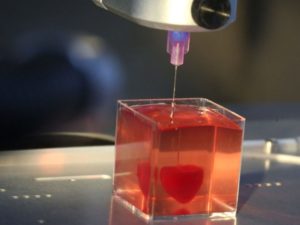This year, the bioprinting community has discovered ways to speed up precision in 3D bioprinting. Even though experts have warned us that 3D printed organs might not be available for a long time, we can’t help the excitement after witnessing crucial progress in 2019 that gets us closer to the possibility of having functional, compatible and working organs and tissues, especially after researchers made significant progress with different tissues and structures. Other relevant research highlights of this year include new bioprinting machines and bioinks, innovation centers and projects from Australia’s bioprinting research community, and a map of bioprinting companies that gave us a clear grasp of the main biotech hubs around the world.
Bioprinters and bioinks
In early November we learned that researchers at Harvard University’s Wyss Institute for Biologically Inspired Engineering created a fast multimaterial 3D printer. Thanks to a unique 3D printed printhead design, users can seamlessly switch between multiple different materials up to 50 times per second. The 3D printing technique called Multimaterial Multinozzle 3D (MM3D) printing could revolutionize the process of printing complex structures and is just one of the many advances in 3D bioprinting coming from Wyss.
On the European front, former regenHu CEO and founder, Mark Thurner, embarked on a new journey after launching his second company, mimiX Biotherapeutics, to bioprint in the operating room using sound. The all new bioprocessing technology called Sound Induced Morphogenesis (SIM) will be launched commercially in the summer and has already demonstrated – with scientific evidence – that it offers tissue engineering strategies to overcome today’s obstacles, for example, the creation of dense networks of cells suitable for micro vascularization.
New bioprinters became commercially available in 2019, including CELLINK’s bioprinting platform for complex structures, the Bio X6, as well as the Lumen X, a digital light processing bioprinter resulting from a joint collaboration between the seasoned company and Volumetric that is designed to enhance inventions in creating more substantial vascular structures. Another Swedish-based biotech company called Fluicell released a high-resolution bioprinting technology in both 2D and 3D called Biopixlar, capable of creating complex tissue-like structures where positioning of individual cells can be controlled from a gamepad, the novel feature that allows users to control the system just like they would a videogame was well received.
Bioink developments this year were plentiful. Companies like Allevi turned out liver-specific bioinks, Biogelx launched their first product range of synthetic bioinks for a variety of 3D printing applications, and the Tessenderlo Group released their first gelatin bioink in their Claro series of tissue-engineering products. As far as academic researchers go, they are not lagging behind, a team of researchers at Texas A&M University have developed a 3D printable hydrogel bioink containing mineral nanoparticles that can deliver protein therapeutics to control cell behavior, while researchers at the Rensselaer Polytechnic Institute and Yale University, turned living human skin cells into a bioink to print artificial skin, which then grows its own blood vessel system. In years to come, once these amazing advances hit the pre-clinical and clinical phases we will see an even bigger revolution in bioprinting.
Cardiac tissue engineering
The Tel Aviv University story about researchers making significant progress with 3D bioprinting by introducing a new concept for engineering fully personalized cardiac patches to repair heart defects, became quite the hype of the year, especially after many news outlets around the world began using the words 3D printed and the human heart in the same headline. Leading many to believe that a functional beating heart that could replace organ transplant was just around the corner. Although researchers actually printed a cellularized heart-like structure with a natural architecture to demonstrate the potential of the approach for organ replacement, the focus of their work was on a novel 3D printing technique that uses patients’ stem cells and extracellular matrix (ECM) to create a personalized hydrogel as a bioink to 3D print thick, vascularized, and perfusable cardiac patches that completely match the immunological, cellular, biochemical, and anatomical properties of the patient, regenerating a previously defective or infarcted heart part.
Some of our most seasoned interviewees suggested that bioprinted organs in the long-term future might not be anatomically designed to look like our organs, but all that matters is that they carry the functions that humans require to live.
A growing bioprinting landscape for Australia
Many of our bioprinting stories this year revolved around biotechnology discoveries, new labs and collaborative research efforts in Australia. The approach to science and research that the country’s experienced professionals have, are consistently about teamwork and collaboration, leading us to believe that perhaps they’re onto something. Constant efforts to enroll researchers in projects between different universities have been aplenty, as well as the myriad of opportunities that they have generated this year to get together and engage in biotechnology to advance the field. Integrated research labs across various universities are booming as more and more students become interested in the engineering, design, medical and biochemical aspects of biofabrication. Leading bioprinting experts Gordon Wallace, Professor at the University of Wollongong, and Jason Chuen, Vascular Surgeon and Director of the 3D Medical Printing Laboratory in Melbourne, have been actively heading and participating in conferences and seminars across the country.
With breakthrough developments like 3D Alek, a bioprinter that replicates human ears for patients with microtia, to creating their own bioinks at the lab, researchers understand that the success of their work comes from sharing knowledge and creativity among peers.
Mapping the companies that make bioprinting successful
To get a better grasp of the landscape that has been building up and what we can expect for the future of bioprinting, 3DPrint.com decided to map out all the companies that are working on developing both bioprinters and bioinks to advance biofabrication. Our Bioprinting World Map offers a snapshot of some of the hubs around the world where biotechnology is taking off, as well as potential startups that could revolutionize the next generation of bio machines. As some of the smaller and new companies are scaling up, coming up with new technology to tackle a competitive environment (such as Aspect Biosystems and CTI Biotech), a few are struggling to stay afloat, like Organovo, and a great deal of university spin-out businesses represent some of the cutting edge research and innovation that is undertaken in faculties and institutes (like OxSyBio, a spin-off from the University of Oxford).
Overall, 2019 was a year of highs. Looking ahead to 2020, we can expect a continued surge in bioprinting research and development as well as an ecosystem of collaboration among scientists. We should also expect top research institutions and leading companies to continue flirting with new technologies to harness the power of 3D bioprinting, as well as continue investigating the functionality of tissues for regenerative medicine. Finally, it will be important to closely analyze the growing popularity of new methods that arise and that may inspire emerging trends in the field.
Join the discussion of this and other 3D printing topics at 3DPrintBoard.com.
Subscribe to Our Email Newsletter
Stay up-to-date on all the latest news from the 3D printing industry and receive information and offers from third party vendors.
Print Services
Upload your 3D Models and get them printed quickly and efficiently.
You May Also Like
Reinventing Reindustrialization: Why NAVWAR Project Manager Spencer Koroly Invented a Made-in-America 3D Printer
It has become virtually impossible to regularly follow additive manufacturing (AM) industry news and not stumble across the term “defense industrial base” (DIB), a concept encompassing all the many diverse...
Inside The Barnes Global Advisors’ Vision for a Stronger AM Ecosystem
As additive manufacturing (AM) continues to revolutionize the industrial landscape, Pittsburgh-based consultancy The Barnes Global Advisors (TBGA) is helping shape what that future looks like. As the largest independent AM...
Ruggedized: How USMC Innovation Officer Matt Pine Navigates 3D Printing in the Military
Disclaimer: Matt Pine’s views are not the views of the Department of Defense nor the U.S. Marine Corps Throughout this decade thus far, the military’s adoption of additive manufacturing (AM)...
U.S. Congress Calls Out 3D Printing in Proposal for Commercial Reserve Manufacturing Network
Last week, the U.S. House of Representatives’ Appropriations Committee moved the FY 2026 defense bill forward to the House floor. Included in the legislation is a $131 million proposal for...



































